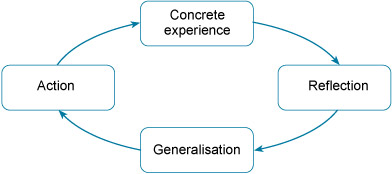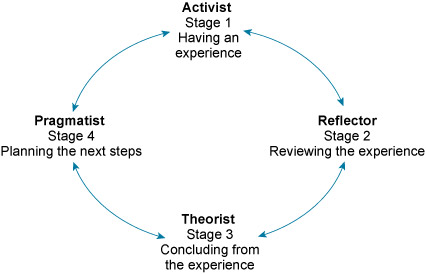1 Using reflection to support learning
Kolb (1976) developed a theory of learning which has subsequently influenced much thinking about reflective and experiential learning. He argued that learning from experience necessarily involves four stages, shown in Figure 1, and that each of these stages draws on different skills and characteristics.

Kolb’s learning cycle shows that learning from experience is about much more than simply acquiring experience (concrete experience) and thinking about what happened (reflection). It also means developing a more general understanding which can be applied in other situations (generalisation) and also finding ways to try out this new learning (action). In practice, Kolb argued that most of us are stronger in one or more of the stages of the cycle than in others and that this presents challenges to managers who want to learn effectively from experience (Kolb, 1976).
Later, Honey and Mumford (2006) developed a widely used learning styles inventory designed to help individuals to identify where they have the greatest strengths and weaknesses on the learning cycle (this mapping of learning styles to the learning cycle is shown in Figure 2).

You may, for example, be someone who spends a great deal of time thinking back and reflecting on what has happened (reflector) and trying to make sense of the reasons for this (theorist) but not so good at deciding what this means for future practice or actually trying out new and different ways of doing things based on your reflections and theorising.
Alternatively, you might be stronger at trying new experiences (activist) and, when they don’t go well, trying another approach (pragmatist) without necessarily going through the process of looking back and making sense of what happened before you make a judgement about what to do next.
In Table 1 below you will see a more detailed account of the characteristics of each of the learning 'types' identified by Honey and Mumford.
| Learning style | Strengths | Weaknesses |
|---|---|---|
| Activist | Flexible and open-minded. Happy to have a go. Happy to be exposed to new situations. Optimistic about anything new and therefore unlikely to resist change. | Tendency to take the immediately obvious action without thinking. Often take unnecessary risks. Tendency to do too much themselves and hog the limelight. Rush into action without sufficient preparation. Get bored with implementation or consolidation. |
| Reflector | Careful. Thorough and methodical. Thoughtful. Good at listening to others and assimilating information. Rarely jump to conclusions. | Tendency to hold back from direct participation. Slow to make up their minds and reach a decision. Tendency to be too cautious and not take enough risks. Not assertive - they aren't particularly forthcoming. |
| Theorist | Logical 'vertical' thinkers. Rational and objective. Good at asking probing questions. Disciplined approach. | Restricted in lateral thinking. Low tolerance for uncertainty, disorder and ambiguity. Intolerant of anything subjective or intuitive. Full of 'shoulds, oughts and musts'. |
| Pragmatist | Keen to test things out in practice. Practical, down to earth, realistic. Businesslike - get straight to the point. Technique oriented. | Tendency to reject anything without an obvious application. Not very interested in theory or basic principles. Tendency to seize on the first expedient solution to a problem. Impatient with waffle. On balance, risk oriented not people oriented. |
Activity 1 Learning styles
Spend some time thinking about the learning styles described in Table 1. Do you recognise any of these styles as very like you or very unlike you? In either case, can you see any advantages to using the style in question rather more or rather less?
Discussion
You can read more about Honey and Mumford's learning style on Peter Honey's website [Tip: hold Ctrl and click a link to open it in a new tab. (Hide tip)] where you can also complete their learning styles inventory (for a fee). Please note that these are optional activities and are not requirements of this course of study. Some commentators have questioned the validity of learning styles inventories because learning styles seem not to be stable and we are able to adapt our learning styles to different circumstances (Harrison, 2009; Gold et al., 2013). However, others argue that it can be very helpful to be self-aware about the approaches you are taking to learning, and to try out new approaches to learning more effectively.
